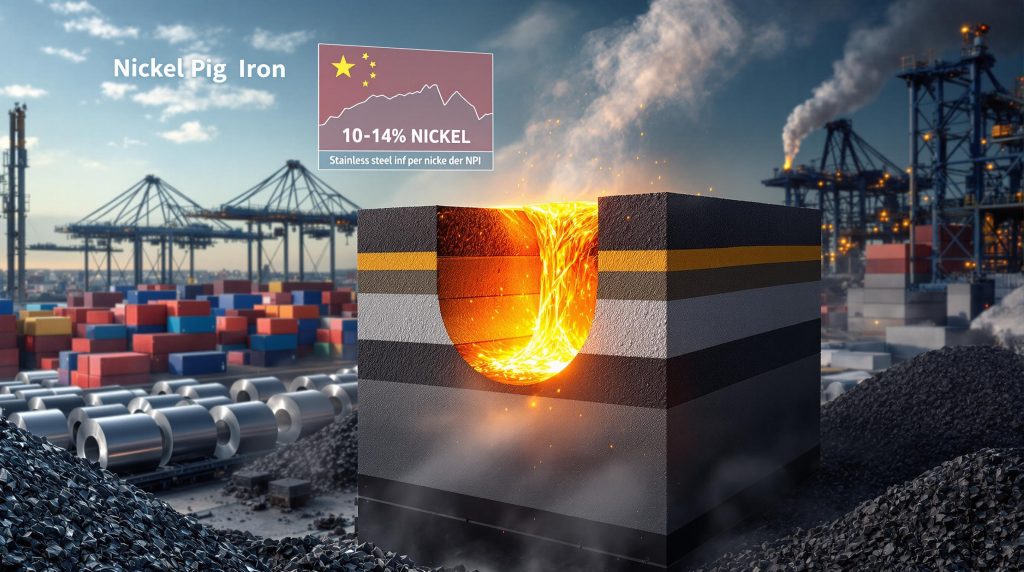Understanding Nickel Pig Iron and Its Market Significance
Nickel pig iron (NPI) has emerged as a crucial raw material in stainless steel production, particularly across Asian markets. This ferronickel product contains varying nickel percentages and serves as a cost-effective alternative to pure nickel importance & uses for steelmakers worldwide. As China continues to dominate global stainless steel production, understanding the nickel pig iron CIF China price assessment becomes increasingly important for industry participants.
High-grade NPI typically contains 10-14% nickel content alongside approximately 80% iron, with strict limits on impurities such as phosphorus (0.04% maximum), sulfur (0.4% maximum), silicon (4.5% maximum), and carbon (4% maximum). These specifications ensure consistent quality for downstream applications.
The material's primary significance lies in its ability to provide nickel units at a lower cost than refined nickel, making it particularly valuable during periods of high nickel prices. By enabling more cost-effective stainless steel production, NPI has fundamentally transformed the global nickel supply chain since its widespread adoption in the early 2000s.
Key Applications and Strategic Importance
The stainless steel industry consumes approximately 70% of global nickel production, with NPI serving as a vital input for 300-series stainless grades. These grades require significant nickel content (8-10%) to achieve their corrosion resistance and mechanical properties. While pure nickel remains the premium input, NPI provides a more economical alternative without significantly compromising final product quality.
Beyond its cost advantages, NPI holds strategic importance in the nickel value chain by:
- Providing price stability during nickel market volatility
- Offering regional supply security for major steel producers
- Creating value-added processing opportunities in nickel-mining countries
- Enabling production flexibility for stainless steel manufacturers
As the electric vehicle industry grows, NPI is also gaining relevance in battery material considerations, with some producers exploring the conversion of NPI to nickel matte for battery precursor applications.
How the CIF China Price Assessment Works
The Fastmarkets nickel pig iron CIF China price assessment (MB-FEN-0008) provides a standardized benchmark for high-grade NPI with 10-14% nickel content. Published weekly every Friday at 3pm London time, this assessment captures the spot market value of NPI delivered to main Chinese ports under Cost, Insurance, and Freight (CIF) terms.
Assessment Methodology Details
The price assessment is denominated in Chinese yuan per nickel unit, reflecting the actual transaction currency used by Chinese buyers. This approach eliminates currency conversion variables and provides direct relevance to the local market. The assessment covers minimum quantities of 500 tonnes per transaction and adheres to strict quality parameters for iron content and impurity levels.
The assessment methodology incorporates:
- Direct transaction data from market participants
- Firm bids and offers with realistic execution potential
- Indicative price levels with market context
- Comparative analysis against related nickel products
All data points undergo rigorous validation to ensure they represent genuine market activity. The assessment team applies consistent normalization procedures to account for variations in payment terms, delivery timing, and quality specifications, ensuring that the final published price accurately reflects standard market conditions.
Data Collection Process
Information gathering for the price assessment involves continuous communication with a diverse range of market participants, including producers, traders, consumers, and brokers. This broad engagement ensures that the assessment captures a representative view of the market from multiple perspectives.
The submission process operates through designated pricing analysts who maintain regular contact with market sources. Participants can provide information via various channels, including:
- Direct communication with pricing analysts
- Structured data submission formats
- Regular market update calls
- Feedback on published assessments
Confidentiality options are available for market participants who wish to contribute pricing information without public attribution. This approach encourages broader market participation while maintaining data integrity through thorough verification processes.
The Strategic Launch of the CIF China Price Assessment
The nickel pig iron CIF China price assessment was launched on August 15, 2025, following a comprehensive consultation period that concluded on August 12, 2025. This timing coincided with significant shifts in global mining landscape and increasing demand for transparent pricing references in the Chinese import market.
Market Evolution Driving the Launch
Several key market developments prompted the establishment of this dedicated price assessment:
- The growth of CIF as a mainstream trading method in the Chinese market, replacing earlier FOB-dominated practices
- Increasing international trade volumes requiring standardized price benchmarks
- Evolving supply dynamics with Indonesian production displacing traditional Philippine material
- Industry requests for greater transparency in China's import pricing
As the world's largest stainless steel producer and nickel consumer, China's import practices significantly influence global nickel markets. The CIF assessment provides critical visibility into this crucial market segment, enabling more informed decision-making throughout the supply chain.
Responding to Industry Needs
The assessment development process incorporated extensive feedback from industry stakeholders to ensure its relevance and utility. Market participants highlighted several specific needs addressed by the new assessment:
- Standardized quality specifications reflecting actual trade parameters
- Yuan-denominated pricing to eliminate currency conversion complexities
- Regular weekly updates capturing market movements
- Transparent methodology with clear normalization procedures
By designing the assessment around these industry requirements, Fastmarkets created a tool that provides genuine value to market participants navigating the complexities of the nickel pig iron trade.
Market Impact of the CIF China Price Assessment
The introduction of a dedicated CIF China price assessment for nickel pig iron creates significant benefits for various stakeholders in the nickel supply chain. Most notably, it enhances price discovery mechanisms for international traders by providing a standardized reference point for negotiations and contract settlements.
Benefits for Market Participants
For international suppliers and traders, the assessment offers:
- Enhanced price discovery for import transactions
- Improved risk management capabilities through benchmark pricing
- Standardized reference point for contract negotiations
- Greater visibility into China's import pricing dynamics
Chinese buyers benefit from:
- Transparent market pricing for procurement planning
- Benchmark comparisons against domestic NPI prices
- Validation of supplier quotations against market consensus
- Better understanding of international supply economics
The assessment also benefits financial institutions and industry analysts by providing reliable data for market analysis, funding decisions, and investment research.
Integration with Existing Assessments
The CIF China assessment complements existing domestic Chinese NPI price assessments, creating a more comprehensive view of the overall market. By comparing domestic and import prices, market participants can identify arbitrage opportunities and optimize sourcing strategies.
As part of Fastmarkets' broader steel raw materials package, the assessment also facilitates cross-commodity analysis, enabling connections between nickel pig iron prices and related materials such as nickel ore, refined nickel, and stainless steel products. This integrated approach provides valuable context for understanding price drivers and market relationships.
Technical Specifications of the Nickel Pig Iron Assessment
The CIF China price assessment follows strict quality parameters to ensure consistency and relevance to actual market practices. These specifications reflect the standard quality requirements for high-grade nickel pig iron used in stainless steel production.
Detailed Quality Parameters
The complete specification includes:
| Parameter | Requirement |
|---|---|
| Physical form | Lump material |
| Nickel content | 10-14% |
| Iron content | 80% |
| Phosphorus | 0.04% maximum |
| Sulfur | 0.4% maximum |
| Silicon | 4.5% maximum |
| Carbon | 4% maximum |
These specifications align with the quality requirements of major Chinese stainless steel producers, ensuring that the assessment captures relevant market activity. The narrow nickel content range (10-14%) focuses on high-grade material that represents the majority of international trade flows.
Commercial Terms and Conditions
In addition to quality specifications, the assessment incorporates standardized commercial terms:
- Minimum quantity: 500 tonnes per transaction
- Timing: Spot delivery
- Location: CIF main Chinese ports
- Price unit: Yuan per nickel unit
- Payment terms: Letter of Credit, Cash, with normalization applied to other payment terms
The assessment team applies consistent normalization procedures to account for variations in commercial terms, ensuring that all data points are adjusted to reflect the standard specification before inclusion in the assessment calculation.
Participating in the Price Assessment Process
Market participants can contribute to the nickel pig iron CIF China price assessment by providing relevant transaction information to designated pricing analysts. This collaborative approach ensures that the assessment accurately reflects actual market conditions and incorporates diverse perspectives from across the supply chain.
Submission Guidelines for Market Participants
To participate effectively in the price assessment process, market participants should:
- Contact designated pricing analysts directly via email
- Provide transaction details including price, volume, quality, and delivery terms
- Specify whether information is for direct attribution or background only
- Submit data within the assessment timing window for inclusion
The assessment team welcomes all relevant market information, including completed transactions, firm bids and offers, and indicative price levels with appropriate context. All submissions undergo thorough verification before inclusion in the assessment calculation.
Submission Tip: When contacting pricing analysts, include the subject line "FAO: Pricing Team, re: nickel pig iron, nickel content 10-14%, cif China" to ensure proper routing of your information.
Transparency Measures and Methodology
The price assessment operates under a transparent methodology that undergoes regular review to ensure continued relevance. Key transparency measures include:
- Public consultation before methodology changes
- Clear documentation of assessment procedures
- Regular review of assessment specifications
- Publication of non-confidential feedback
These measures ensure that market participants understand how the assessment is calculated and have opportunities to provide input on potential improvements. The methodology documentation is publicly available and outlines the specific procedures for data driven operations for collection, validation, and assessment calculation.
Evolving Trends in the Global NPI Market
The nickel pig iron market continues to evolve rapidly, driven by shifting production centers, changing trade policies, and fluctuating demand patterns. Understanding these dynamics is essential for interpreting price movements and anticipating future market developments.
Supply Dynamics Reshaping the Market
The most significant supply-side development has been Indonesia's emergence as the dominant global NPI producer, displacing traditional suppliers such as the Philippines. This shift resulted from Indonesia's implementation of ore export restrictions, encouraging the development of domestic processing capacity through significant Chinese investment.
Key supply trends include:
- Indonesian production expansion through new pyrometallurgical facilities
- Environmental restrictions limiting Chinese domestic NPI output
- Seasonal production fluctuations in the Philippines affecting ore availability
- Technology improvements reducing production costs and expanding viable feedstock options
Production technology continues to advance, with improved furnace designs enabling more efficient nickel recovery and lower energy consumption. These advancements have gradually reduced the cost curve for NPI production, allowing producers to remain competitive even during periods of lower nickel prices.
Demand Factors Influencing Consumption
Demand for nickel pig iron remains primarily driven by stainless steel production rates, particularly in China. The 300-series stainless grades, which require significant nickel content, represent the primary end market for NPI. Fluctuations in stainless steel production directly impact NPI demand and pricing.
Additional demand factors include:
- Substitution economics versus pure nickel based on relative price spreads
- Environmental regulations affecting stainless steel production methods
- Competition from scrap-based production routes
- Emerging applications in battery material processing
The substitution relationship between NPI and pure nickel creates important price dynamics, with consumers shifting between inputs based on relative economics. When LME nickel prices rise significantly, stainless producers typically increase NPI usage to control costs, supporting NPI premiums.
NPI's Position in the Broader Nickel Market
Nickel pig iron occupies a strategic position within the broader nickel market ecosystem, serving as a bridge between primary nickel ore production and finished stainless steel. Understanding this position helps contextualize price movements and market relationships.
Relationship to Other Nickel Products
NPI pricing maintains complex relationships with other nickel products:
- LME Nickel: While NPI prices correlate with LME nickel movements, the relationship is not perfectly linear due to production cost structures and substitution effects
- Nickel Ore: As the primary feedstock for NPI production, ore prices directly influence NPI production costs
- Ferronickel: Traditional FeNi competes directly with NPI in stainless applications, creating price linkages
- Nickel Matte/Sulfate: Emerging conversion routes from NPI to battery materials are creating new market connections
These relationships create a complex price ecosystem where movements in one segment can trigger ripple effects throughout the nickel value chain. Market participants increasingly monitor multiple nickel product forms to develop comprehensive market views.
Strategic Importance for Market Participants
NPI's strategic importance extends beyond its immediate commercial applications:
- For stainless producers: Provides cost flexibility and supply security
- For miners: Creates alternative market channels for lower-grade nickel ores
- For traders: Offers arbitrage opportunities across nickel product forms
- For analysts: Serves as an indicator of Chinese industrial activity
- For investors: Provides insights into broader mining economics insights
The material's position as a cost-effective nickel unit source gives it significant influence on overall nickel price formation, particularly during periods of supply constraints or demand surges. Understanding NPI market dynamics has become essential for all participants in the nickel value chain.
FAQ: Understanding the Nickel Pig Iron CIF China Price Assessment
What exactly does the CIF designation mean for this price assessment?
The CIF (Cost, Insurance, Freight) designation indicates that the quoted price includes three components: the cost of the NPI itself, insurance during transit, and all transportation costs to the specified destination ports in China. This pricing basis reflects the actual landed cost for Chinese buyers, making it directly relevant for import procurement decisions.
How does this assessment differ from existing NPI price benchmarks?
This assessment specifically focuses on imported material arriving at Chinese ports, whereas other assessments may track domestic Chinese production or ex-works pricing from producing countries like Indonesia. The CIF basis captures the full cost of bringing material into China, including international freight and insurance, which can represent significant components of the total cost.
Why is the price quoted in yuan rather than dollars?
The yuan-denominated price reflects the actual transaction currency used by Chinese buyers and provides direct relevance to the local market without currency conversion variables. While international traders may negotiate in dollars, the final settlement often occurs in yuan, making this denomination more directly applicable to the largest consumer market.
How frequently is the methodology reviewed?
Fastmarkets conducts regular reviews of its methodology to ensure continued relevance and accuracy in reflecting market conditions. Formal methodology reviews occur at least annually, with additional reviews possible in response to significant market changes or participant feedback. All methodology changes undergo public consultation before implementation.
What time period does each weekly assessment cover?
Each weekly assessment captures market activity from the previous Friday through the current assessment day (Friday). However, greater weight is typically given to more recent data points to ensure the assessment reflects current market conditions at the time of publication.
Important Note: While the assessment provides valuable market insights, it should be considered alongside other factors when making business decisions. Market conditions can change rapidly, and individual transactions may reflect specific circumstances not captured in the assessment.
With ongoing mining transformation trends and high nickel pig iron prices continuing to impact the market, staying informed about current price assessments is critical for stakeholders throughout the nickel supply chain.
Ready to Stay Ahead in the Nickel Market?
Get instant alerts on significant nickel discoveries and market-moving ASX announcements with Discovery Alert's proprietary Discovery IQ model, helping you identify actionable investment opportunities before the broader market. Visit our discoveries page to see how major mineral finds have delivered exceptional returns and start your 30-day free trial today.




